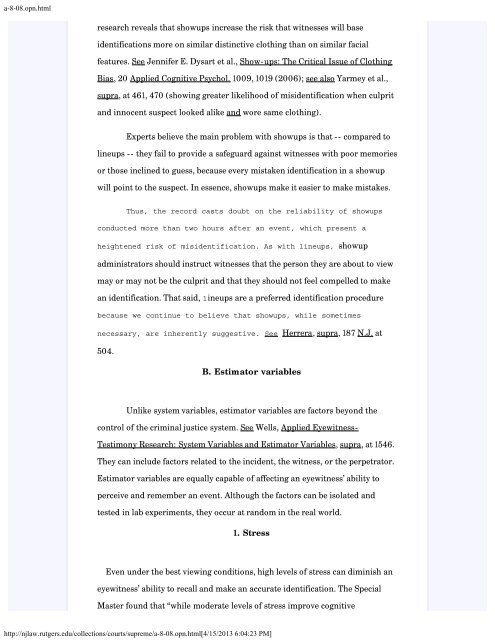State v. Henderson and the New Model Jury Charges - New Jersey ...
State v. Henderson and the New Model Jury Charges - New Jersey ...
State v. Henderson and the New Model Jury Charges - New Jersey ...
Create successful ePaper yourself
Turn your PDF publications into a flip-book with our unique Google optimized e-Paper software.
a-8-08.opn.html<br />
research reveals that showups increase <strong>the</strong> risk that witnesses will base<br />
identifications more on similar distinctive clothing than on similar facial<br />
features. See Jennifer E. Dysart et al., Show-ups: The Critical Issue of Clothing<br />
Bias, 20 Applied Cognitive Psychol. 1009, 1019 (2006); see also Yarmey et al.,<br />
supra, at 461, 470 (showing greater likelihood of misidentification when culprit<br />
<strong>and</strong> innocent suspect looked alike <strong>and</strong> wore same clothing).<br />
Experts believe <strong>the</strong> main problem with showups is that -- compared to<br />
lineups -- <strong>the</strong>y fail to provide a safeguard against witnesses with poor memories<br />
or those inclined to guess, because every mistaken identification in a showup<br />
will point to <strong>the</strong> suspect. In essence, showups make it easier to make mistakes.<br />
Thus, <strong>the</strong> record casts doubt on <strong>the</strong> reliability of showups<br />
conducted more than two hours after an event, which present a<br />
heightened risk of misidentification. As with lineups, showup<br />
administrators should instruct witnesses that <strong>the</strong> person <strong>the</strong>y are about to view<br />
may or may not be <strong>the</strong> culprit <strong>and</strong> that <strong>the</strong>y should not feel compelled to make<br />
an identification. That said, lineups are a preferred identification procedure<br />
because we continue to believe that showups, while sometimes<br />
necessary, are inherently suggestive. See Herrera, supra, 187 N.J. at<br />
504.<br />
B. Estimator variables<br />
Unlike system variables, estimator variables are factors beyond <strong>the</strong><br />
control of <strong>the</strong> criminal justice system. See Wells, Applied Eyewitness-<br />
Testimony Research: System Variables <strong>and</strong> Estimator Variables, supra, at 1546.<br />
They can include factors related to <strong>the</strong> incident, <strong>the</strong> witness, or <strong>the</strong> perpetrator.<br />
Estimator variables are equally capable of affecting an eyewitness’ ability to<br />
perceive <strong>and</strong> remember an event. Although <strong>the</strong> factors can be isolated <strong>and</strong><br />
tested in lab experiments, <strong>the</strong>y occur at r<strong>and</strong>om in <strong>the</strong> real world.<br />
1. Stress<br />
Even under <strong>the</strong> best viewing conditions, high levels of stress can diminish an<br />
eyewitness’ ability to recall <strong>and</strong> make an accurate identification. The Special<br />
Master found that “while moderate levels of stress improve cognitive<br />
http://njlaw.rutgers.edu/collections/courts/supreme/a-8-08.opn.html[4/15/2013 6:04:23 PM]
















